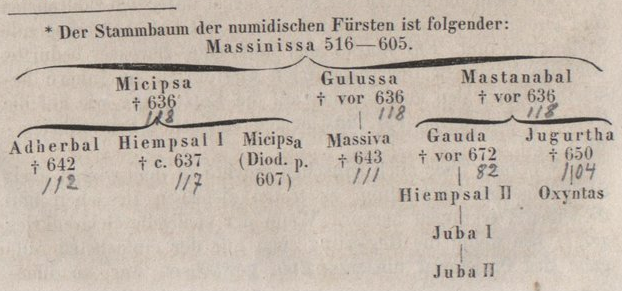Horizontale Klammerungen
Einen Spezialfall bilden Stammbäume, die in der Regel mittels
horizontalen Klammerungen visualisiert werden. Sie
werden als Tabellen wiedergegeben
(<table>,
<row>,
<cell>). Dabei erhält das
<cell>-Element ein
@rendition-Attribut mit den
möglichen Werten "#topBraced" (für
Klammerungen oberhalb der betreffenden Zelle) und
"#bottomBraced" (für
Klammerungen unterhalb der betreffenden Zelle).
Umgang mit horizontalen Klammerungen

<note place="foot" n="*">Der Stammbaum der numidischen Fürsten ist folgender:<lb/> <table> <row> <cell cols="6" rendition="#bottomBraced"><hi rendition="#g">Massinissa</hi> 516-605.</cell> </row> <row> <cell cols="3" rendition="#bottomBraced"><hi rendition="#g">Micipsa</hi><lb/>† 636</cell> <cell rendition="#bottomBraced"><hi rendition="#g">Gulussa</hi><lb/>† vor 636</cell> <cell cols="2" rendition="#bottomBraced"><hi rendition="#g">Mastanabal</hi><lb/>† vor 636</cell> </row> <row> <cell rows="4"><hi rendition="#g">Adherbal</hi><lb/>† 642</cell> <cell rows="4"><hi rendition="#g">Hiempsal</hi> I<lb/>† c. 637</cell> <cell rows="4">Micipsa<lb/>(Diod. p. † 607)</cell> <cell rows="4">Massiva<lb/>† 643</cell> <cell rendition="#bottomBraced"><hi rendition="#g">Gauda</hi><lb/>† vor 672</cell> <cell><hi rendition="#g">Jugurtha</hi><lb/>† 650</cell> </row> <row> <cell rendition="#bottomBraced"><hi rendition="#g">Hiempsal</hi> II</cell> <cell rows="3">Oxyntas</cell> </row> <row> <cell rendition="#bottomBraced"><hi rendition="#g">Juba</hi> I</cell> </row> <row> <cell><hi rendition="#g">Juba</hi> II</cell> </row> </table> </note>
